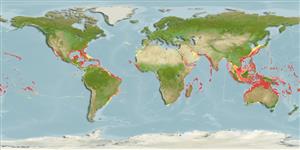Common names from other countries
Environment: milieu / climate zone / depth range / distribution range
Écologie
; profondeur 1 - 150 m (Ref. 80410). Tropical
Distribution
Pays | Zones FAO | Écosystèmes | Occurrences | Introductions
Circumtropical.
Length at first maturity / Taille / Poids / Âge
Maturity: Lm ? range ? - ? cm Max length : 9.0 cm TL mâle / non sexé; (Ref. 3099)
Maximum depth from Ref. 96667. Found on seagrass beds and coral rubble cavities (Ref. 80410, 83920), particularly in subtidal and intertidal areas (Ref. 83920).
Life cycle and mating behavior
Maturité | Reproduction | Frai | Œufs | Fécondité | Larves
Some members of the order Stomatopoda pair for life and some come together only to mate. Males produce sperm ducts rather than spermatophores; females can brood a maximum of 50,000 eggs. Life cycle: Eggs hatch to a planktonic zoea which lasts for 3 months.
Coelho Filho, P.A. 2004. (Ref. 2364)
Statut dans la liste rouge de l'IUCN (Ref. 130435)
statut CITES (Ref. 108899)
Not Evaluated
Not Evaluated
Utilisations par l'homme
| FishSource |
Outils
Plus d'informations
Taille/ÂgeCroissanceLongueur-poidsLongueur-longueurMorphologieLarvesAbondance
Sources Internet
Estimates based on models
Preferred temperature
(Ref.
115969): 22.5 - 28.7, mean 27 (based on 1742 cells).
Vulnérabilité
Low vulnerability (10 of 100).
Catégorie de prix
Unknown.
